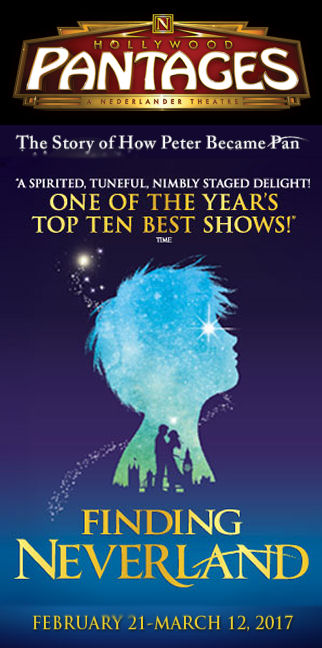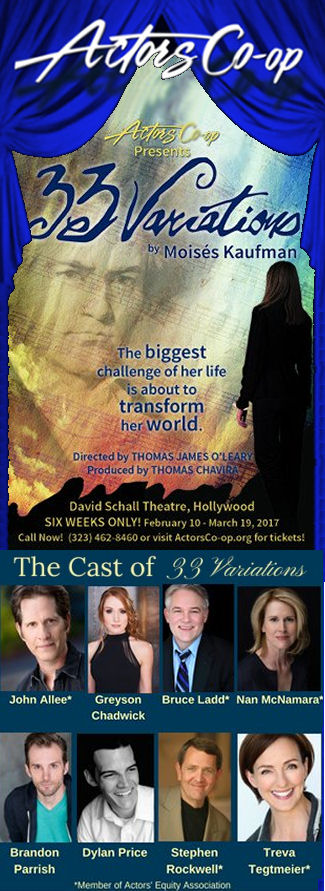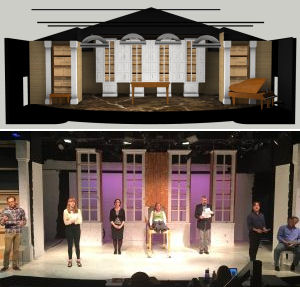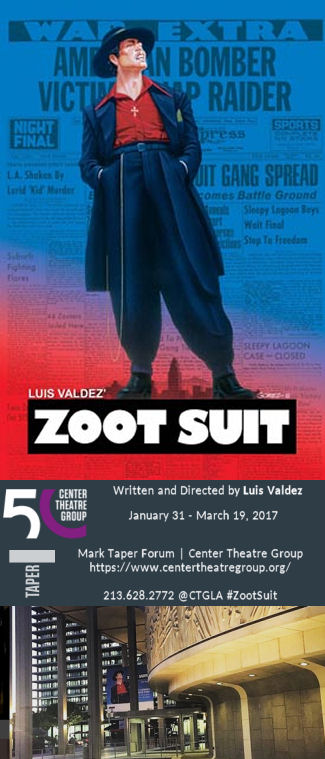
 From where does inspiration arise? What gives the author the impetus to write a story, particularly an imaginative story? These are the questions that underlie the musical Finding Neverland (FB), currently at the Hollywood Pantages (FB) through March 12. The original production opened on Broadway in March 2015, closing in August 2016 after 565 performances — a respectable run. I discovered the production through the cast album, which I found enjoyable. The musical, with book by James Graham, and music and lyrics by Gary Barlow (FB) and Eliot Kennedy, was based on the 2004 Miramax movie of the same name by David Magee and the play The Man Who Was Peter Pan by Allan Knee.
From where does inspiration arise? What gives the author the impetus to write a story, particularly an imaginative story? These are the questions that underlie the musical Finding Neverland (FB), currently at the Hollywood Pantages (FB) through March 12. The original production opened on Broadway in March 2015, closing in August 2016 after 565 performances — a respectable run. I discovered the production through the cast album, which I found enjoyable. The musical, with book by James Graham, and music and lyrics by Gary Barlow (FB) and Eliot Kennedy, was based on the 2004 Miramax movie of the same name by David Magee and the play The Man Who Was Peter Pan by Allan Knee.
It is clear that the story of this boy that would never grow up, and his creation by J. M. Barrie, has fascinated people for generations (especially as the original story has gone in and out of copyright protection). It has spawned both prequel (Pan (2015)) and sequel (Hook (1991)) movies, as well as various reinterpretations and origin stories for the stage (Peter and the Starcatcher, Peter Pan: The Boy Who Hated Mothers), the latter being based on Barrie’s novel Peter and Wendy.
The version of the story on the stage at the Pantages, as in the movie, is a fictionalized version of the real story. There are a number of elements in common, but there is rearrangement of both the relationships and the timeline. One wonders if the fascination with the story is because society inherently distrusts any relationship of an adult man with boys not his own. I’d hazard a guess that this is a preoccupation of the modern era; it may have been more common and innocent in the past. In any case, that intimation of creepy relationships that I raised in some biographical descriptions of Barrie are not present in this musical; rather, it expands on the notion of Neverland coming from a rediscovery of the author’s imagination.
Before I go further into giving my thoughts on the piece, perhaps a plot summary is in order. Here’s the summary from Musical Heaven:
After a less than successful opening of his latest play Little Mary, J. M. Barrie meets widowed Sylvia and her sons in Kensington Gardens and they all soon develop a strong bond. J. M. Barrie proves to be a great friend and father figure to the boys, and his antics with the children quickly begin to inspire him to write a play about boys who never wish to grow up, with youngest son Peter provides particular inspiration. Soon, people begin to question his relationship with Sylvia, although it remains fiercely platonic. His wife Mary divorces him and Sylvia’s mother starts to object at the amount of time Barrie spends with the family. Sylvia becomes increasingly weak after an illness, but Barrie continues to play with the boys, taking the adventures they experience and turning them into Peter Pan. Presenting his idea to Producer Charles Frohman, Frohman reluctantly agrees to put on the play, despite believing that it will not appeal to his upper-class theatregoers. Barrie takes it on himself to disperse children from a local orphanage throughout the audience, which causes the surrounding adults to delight in the play. Proving a huge success, Peter Llewelyn Davies arrives to watch the show and realizes that it is about him and his brothers; George, Michael and Jack. Too ill to attend the theatre, Barrie puts on a production for Sylvia in her home, gathering the actors, props and musicians in her house. At the end, Peter Pan points to the doors to signify that she should go to Neverland. She takes the hand of her boys and walks into Neverland, implying her death. At Sylvia’s funeral, Barrie discovers that her will reads that he should take care of the Llewelyn Davies boys, which he is overjoyed at. Barrie and Peter form a bond unlike any other.
Reviews of the show that I read before seeing it criticized this plot, arguing that it had no antagonist. One gets the feeling that they were looking for a conventional theatrical structure: protagonists, antagonists, charm songs, 11 o’clock numbers, “I want” songs, and so forth. That’s not here. If there was any antagonist, it might have been Barrie against itself; however, more than anything, I think this was just an attempt to tell a story. Stories do not always have good guys and bad guys — sometimes they just are. This is especially true in an origin story about something well known. One knows the ending in advance — the question is how they got there.
Where I believe the critics did have a valid complaint is the music. The reviews I read called it pedestrian. I wouldn’t go that far. This is the first score from a team that had previously done pop music. The pop music can successfully develop musicals given the right coaching, guidance, and skill. Good examples of this Sir Elton John, Cyndi Lauper, and Sara Bareilles. But they can also go bad, as demonstrated by Paul Simon and Sting, both of whom had musicals that underwhelmed. The problem with much of the score in this show is that is sounded like pop music; they moved the story along but something was missing. This didn’t make them bad, mind you. They were more…. calculated for the pop ear, if I had to say anything. I think this is best exemplified by the fact that there is a companion album to the cast album that presents pop music stars performing these songs. There is one exception, however: the song “Play”, which is one of the ones very theatrical in its nature.
Irrespective of any story issues, the execution and presentation of the story were great (not surprising for a Broadway Equity tour). As directed by Diane Paulus, with choreography by Mia Michaels (FB), the characters come to life — in particular, the leads — with playfulness and movement as befits the story.
In the lead positions were Billy Harrigan Tighe (FB) as J. M. Barrie and Christine Dwyer (FB) as Sylvia Llewelyn Davis. Both gave great performances, with displays of the impishness and childishness needed for the characters. They also had very pleasant and strong singing voices — in particular, Dwyer at times reminded me of Allison Fraser with the touch of a really interesting vocal nuance to her voice. Tighe did a beautiful job on numbers such as “When Your Feet Don’t Touch The Ground”, with Dwyer excelling in numbers like “What You Mean to Me”.
As Charles Frohman, Barrie’s producer, Tom Hewitt was strong and very funny. He came into his own, however, when portraying Barrie’s alter-ego, Captain Hook. Playful and maniacal, he was just a joy to watch. In terms of singing, I found him very strong in songs such as “Circus of Your Mind”, “Hook”, and in particular, “Play”.
The Llewelyn Davies children are portrayed by multiple actors; the actors we saw at this performance are italicized: George – Finn Faulconer, Ben Krieger, Colin Wheeler; Peter – Ben Krieger, Colin Wheeler, Mitchell Wray; Jack: Tyler Patrick Hennessy, Colin Wheeler, Mitchell Wray; and Michael – Jordan Cole, Tyler Patrick Hennessy. All were cute and fun to watch and sang well. I was particularly impressed with them in the second act where one plays ukulele (and considering they rotate, this means that most play uke).
Although there was no formal bio in the program, stealing the hearts of the audience as Porthos was Sammy, in what appears to be his debut performance. Seriously, this dog was very cute and very well behaved — especially notable for his reaction to the other “dog” in the second act. Surprisingly, Sammy has an understudy, Bailey. Note: There is no connection to the other famous dog named Porthos.
Rounding out the cast in other smaller named roles and ensemble positions were: Karen Murphy [Mrs. du Maurier]; Christina Belinsky (FB) [Ensemble, Peter Pan u/s]; Cameron Bond (FB) [Ensemble, Mr. Turpin, Acting Troupe Captain Hook, u/s J. M. Barre]; Sarah Marie Charles (FB) [Ensemble, u/s Sylvia, u/s Mary]; Adrianne Chu (FB) [Ensemble, Acting Troupe Wendy]; Calvin L. Cooper (FB) [Ensemble]; Dwelvan David (FB) [Ensemble, Mr. Henshaw]; Nathan Duszny (FB) [Ensemble]; Victoria Huston-Elem (FB) [Ensemble; Miss Bassett, u/s Mrs. du Maurier]; Crystal Kellogg (FB) [Mary Barrie, u/s Sylvia]; Thomas Miller (FB) [Ensemble, Elliot]; Noah Plomgren (FB) [Ensemble, Lord Cannan, u/s J. M. Barrie]; Corey Rives (FB) [Ensemble, Albert]; Dee Tomasetta (FB) [Ensemble, Peter Pan]; Lael Van Keuren (FB) [Ensemble, Miss Jones, Emily, u/s Mrs. du Maurier, u/s Mary]; and Matt Wolpe (FB) [Ensemble, Mr. Cromer, u/s Frohman/Hook]. I particularly enjoyed Dwelvan David’s ensemble performance — very expressive. Somebody cast this guy as the Genie in Aladdin — he has the right look and fun. Swings were Melissa Hunter McCann (FB) [Swing]; Connor McRory (FB) [Swing]; and Matthew Quinn (FB) [Swing, u/s Frohman/Hook].
The music was under the direction of Ryan Cantwell (FB), with music supervision by Fred Lassen (FB) and Orchestrations by Simon Hale (FB). The orchestra consisted of Ryan Cantwell (FB) (Conductor / Keyboard), Valerie Gebert (FB) (Associate Conductor / Keyboard), Greg Germann (FB) (Drums), Laraine Kaizer (FB) (Violin), Ryan Claus/FB (Reeds), Sean Murphy (FB) (Bass), Nicholas Difabbio (FB) (Guitar), David Manning (FB) (Synth / Acoustic Guitar / Mandolin), Kathleen Robertson (FB) (Violin), Ken Wild (Bass / Electric Bass), John Yoakum (FB) (Flute / Piccolo / Clarinet / F# Wood Flute). The keyboard sub was David Witham (FB), and the orchestra contractor was Brian Miller. The orchestra had a good sound to it, but beware there is loads of bass at the end of Act I. The original music supervisor and dance and incidental music arranger was David Chase.
Lastly, the production creative team: The scenic design by Scott Pask was relatively simple with a framing scrim (that blocked the view from the side, but narrowed the stage to a standard size for the tour 😞 ). The bulk of the scenic aspects were provided by the projection design of Jon Driscoll. This worked with the lighting design of Kenneth Posner to create most of the magic. I was particularly taken by a scene in the second act that made wonderful use of shadow effects of the actors on stage created by a single white light projecting on the actors from upstage. Speaking of magic, the real magic in this show came from the illusions of Paul Kieve, the air sculpture of Daniel Wurtzel, and the flying effects of Production Resource Group. The effects these folks created near the finale are spectacular. The sound design by Jonathan Deans was reasonably good, but shows need to remember when booking the Pantages that all the lovely art deco flourishes in the auditorium, while great to look at, bounce the sound everywhere (and require special tuning). The costumes by Suttirat Anne Larlarb and the hair and makeup by Richard Mawbey looked good and worked well. Rounding out the production credits are: AnnMarie Milazzo – Vocal Designer; William Berloni – Animal Trainer; Stewart/Whitley – Casting; The Booking Group – Tour Booking; Mia Walker – Associate Director; Gregory Vander Ploeg – General Manager; Jose Solivan – Company Manager; Seth F. Barker – Production Stage Manager.
Finding Neverland continues at the Hollywood Pantages (FB) through March 12. Tickets are available through the Pantages website/box office; discount tickets may be available through Goldstar. Although this isn’t a perfect show, I found it quite enjoyable.
🎩 🎩 🎩
Ob. Disclaimer: I am not a trained theatre (or music) critic; I am, however, a regular theatre and music audience member. I’ve been attending live theatre and concerts in Los Angeles since 1972; I’ve been writing up my thoughts on theatre (and the shows I see) since 2004. I do not have theatre training (I’m a computer security specialist), but have learned a lot about theatre over my many years of attending theatre and talking to talented professionals. I pay for all my tickets unless otherwise noted. I am not compensated by anyone for doing these writeups in any way, shape, or form. I currently subscribe at Cabrillo Music Theatre (FB), the Hollywood Pantages (FB), Actors Co-op (FB), the Chromolume Theatre (FB) in the West Adams district, and a mini-subscription at the Valley Performing Arts Center (VPAC) (FB). Through my theatre attendance I have made friends with cast, crew, and producers, but I do strive to not let those relationships color my writing (with one exception: when writing up children’s production, I focus on the positive — one gains nothing except bad karma by raking a child over the coals). I believe in telling you about the shows I see to help you form your opinion; it is up to you to determine the weight you give my writeups.
Upcoming Shows: March quiets down a bit — at least as currently scheduled — with the MRJ Man of the Year dinner, Fun Home at the Ahmanson Theatre (FB) at the beginning of the month, Martha, a one-woman play on the life of Martha Graham (a good preparation for our May VPAC show of her dance group), at the Whitefire Theatre (FB) in the middle, and An American in Paris at the Hollywood Pantages (FB) at the end of the month. April starts with Cats Paw at Actors Co-op (FB) and a concert with Tom Paxton and the DonJuans at McCabes Guitar Shop (FB) (shifting Cats Paws to an afternoon matinee that day). The next day brings the Colburn Orchestra at the Valley Performing Arts Center (VPAC) (FB). The next weekend is currently open (and will likely stay that way). Mid-April brings Doc Severinsen and his Big Band at Valley Performing Arts Center (VPAC) (FB) on April 13, followed by Animaniacs Live at the La Mirada Performing Arts Center (FB) over the weekend. That will be followed on the penultimate weekend of April with Sister Act at Cabrillo Music Theatre (FB). Lastly, looking to May, the schedule shows that it starts with My Bodyguard at the Hollywood Pantages (FB) the first weekend. It continues with Martha Graham Dance and American Music at the Valley Performing Arts Center (VPAC) (FB). The third weekend brings the last show of the Actors Co-op (FB) season, Lucky Stiff, at Actors Co-op (FB). May concludes with Hello Again at the Chromolume Theatre (FB). As for June? Three words: Hollywood Fringe Festival (FB). That, barring something spectacular cropping up, should be the first half of 2017.
As always, I’m keeping my eyes open for interesting productions mentioned on sites such as Better-Lemons, Musicals in LA, @ This Stage, Footlights, as well as productions I see on Goldstar, LA Stage Tix, Plays411 or that are sent to me by publicists or the venues themselves. Note: Lastly, want to know how to attend lots of live stuff affordably? Take a look at my post on How to attend Live Theatre on a Budget.
P.S.: The Hollywood Pantages (FB) announced their 2017-2018 season (which was the rest of 2018, after Hamilton took over the last 5 months of 2017) on February 7th. You can find my reaction to it here. The Ahmanson Theatre (FB) announcement was this week, and here’s what I thought of it.


 Just before Christmas 2016,
Just before Christmas 2016,  So how did I do? The Pantages announced a six show season. Five of the six were on my Pantages list, one was on my Ahmanson list: Aladdin, School of Rock, Love Never Dies, The Color Purple, On Your Feet, and Waitress. So lets see how I did for the Ahmanson, based on
So how did I do? The Pantages announced a six show season. Five of the six were on my Pantages list, one was on my Ahmanson list: Aladdin, School of Rock, Love Never Dies, The Color Purple, On Your Feet, and Waitress. So lets see how I did for the Ahmanson, based on 
 As you may recall, I’ve been trying to predict
As you may recall, I’ve been trying to predict 
 Almost
Almost  The production was elegantly adapted for the small stage. Of the Ahmanson production, I wrote: “The primary motif was that of an archival room with shelves and shelves of archive boxes, together with movable screens made up of pages of music. Upon these were occasionally projected movements, scenery, and movements.” This production was unable to do that; instead they used the design of the set you see to the right: four windowed panels with doors between them. These panels could be translucent; the could show archival books. The doors could house projections. On the side were brick walls that slid open to expose archival books; there was also a Murphy bed for one scene behind the books. Credit for this design goes to
The production was elegantly adapted for the small stage. Of the Ahmanson production, I wrote: “The primary motif was that of an archival room with shelves and shelves of archive boxes, together with movable screens made up of pages of music. Upon these were occasionally projected movements, scenery, and movements.” This production was unable to do that; instead they used the design of the set you see to the right: four windowed panels with doors between them. These panels could be translucent; the could show archival books. The doors could house projections. On the side were brick walls that slid open to expose archival books; there was also a Murphy bed for one scene behind the books. Credit for this design goes to  Back in 2014, we saw
Back in 2014, we saw 
